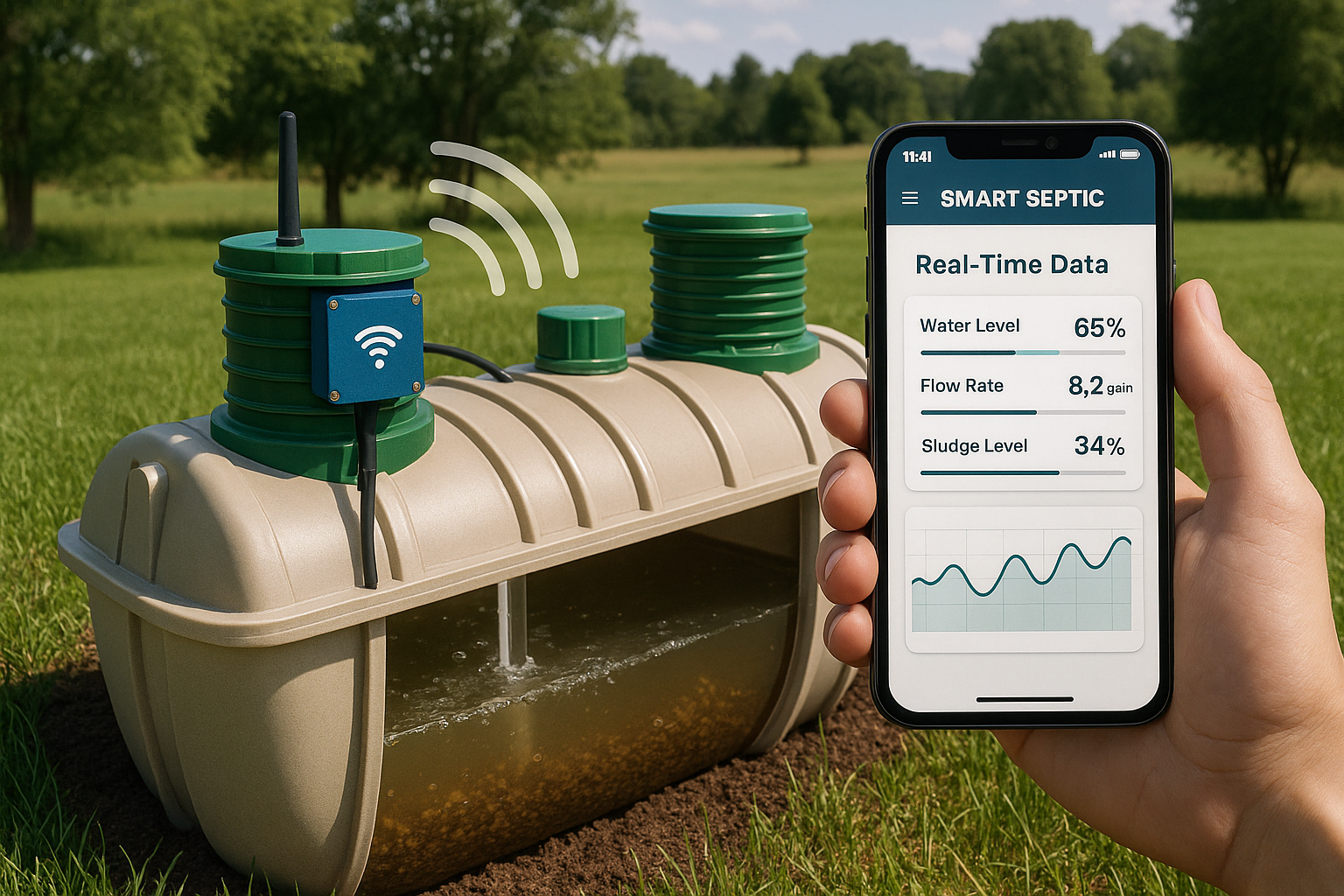Have you ever wondered what’s really happening inside your septic system? For many homeowners and businesses, the inner workings of a septic system remain a mystery until an issue arises, often resulting in costly and stressful repairs. Imagine a scenario where real-time water quality tracking and automated septic alerts inform you of potential issues before they escalate. That’s now possible thanks to smart wastewater monitoring and IoT septic tank sensors.
These smart solutions allow for predictive maintenance septic, wireless septic monitoring, and connected sanitation systems that help homeowners and businesses stay ahead of problems. IoT-enabled tank inspection and smart effluent sensors provide insights into tank levels, flow irregularities, and sludge accumulation, creating a more responsive, proactive approach to wastewater management. Remote sewage management and IoT water treatment solutions further optimize system performance and efficiency. Learn more about the pump-out process for septic systems to understand how maintenance works alongside smart technologies.
In addition to preventing expensive emergencies, these technologies reduce environmental risks and improve operational efficiency. Digital wastewater analytics and cloud-based wastewater monitoring provide data-driven insights, enabling intelligent sewage tracking, automated septic alerts, and sensor-based sludge monitoring. With these tools, you gain control, convenience, and peace of mind while ensuring wastewater performance optimization.
Integrating smart septic system kits, smart drainage management, and IoT sanitation devices into your routine transforms an unseen system into a manageable, reliable, and trustworthy part of your property. Whether for a home, business, or commercial property, these innovations represent the future of proactive, sustainable wastewater management. For homeowners interested in cost-effective care, DIY pump-out risks and benefits provide useful insights.
The Evolution of Smart Tech in Wastewater Management
Septic systems have long been essential for homes and businesses, yet their operation has remained largely hidden. Traditionally, property owners relied on routine pumping schedules, manual inspections, or the unpleasant surprise of system backups to gauge performance. Over time, improvements in plumbing design and environmental engineering made septic systems more efficient, but monitoring stayed mostly reactive. That changed with the advent of IoT, which enables continuous smart wastewater monitoring and real-time septic notifications.
IoT integrates connected sanitation systems, wireless septic monitoring, and IoT water treatment solutions to provide seamless oversight. Tank level monitoring systems, remote sewage management, and sensor-based sludge monitoring allow property owners to track septic health proactively. With predictive maintenance septic, these tools identify patterns before they become critical issues, reducing emergency interventions and avoiding costly repairs. Smart drainage management and intelligent sewage tracking ensure system efficiency, while cloud-based wastewater monitoring enables data access from anywhere.
Digital wastewater analytics further enhance decision-making by providing long-term insights, facilitating wastewater performance optimization. IoT-enabled tank inspection and smart effluent sensors allow homeowners, businesses, and municipal services to monitor systems remotely, minimizing human error and resource waste. For guidance on protecting systems during adverse weather, check out protecting your septic system from heavy rain and flooding.
Ultimately, IoT transforms septic systems from reactive necessities into proactive assets. Remote pipeline monitoring and remote septic diagnostics give users visibility, convenience, and peace of mind. With connected wastewater infrastructure and smart septic system kits, property owners can optimize maintenance, reduce costs, and adopt sustainable practices while improving safety and operational efficiency.
How IoT-Enabled Septic Systems Actually Work
IoT-enabled septic systems operate on the principle of real-time visibility and proactive monitoring. Unlike traditional setups that rely on periodic inspections or manual checks, smart septic system apps, wireless septic monitoring, and IoT sanitation devices continuously track performance. Tank level monitoring systems, smart effluent sensors, and sensor-driven effluent control measure liquid levels, sludge accumulation, and flow irregularities, giving property owners timely insights.
Data from these devices is transmitted via cloud-based wastewater monitoring platforms, allowing homeowners, businesses, or municipal operators to access information from anywhere. Automated septic alerts and real-time septic notifications ensure issues are flagged immediately, reducing downtime and preventing emergencies. Digital wastewater analytics and intelligent sewage tracking further help with long-term maintenance planning and predictive water management. IoT-enabled tank inspection supports proactive interventions, while smart drainage management and connected sanitation systems streamline system operation.
Key components include:
- Sensors and Probes – Measure levels, flow rates, and sludge using smart effluent sensors and sensor-driven effluent control.
- Data Transmission – Wireless transmission ensures continuous monitoring through cloud-based wastewater monitoring.
- Monitoring Platforms – Dashboards and apps provide intuitive insights using remote wastewater diagnostics and IoT septic maintenance tools.
- Alerts and Notifications – Automated septic alerts and real-time septic notifications notify users instantly.
- Analytics and Insights – Digital sludge management and wastewater performance optimization help predict maintenance schedules.
These systems allow homeowners to address potential issues before they escalate, while businesses can monitor performance to maintain operational efficiency. Remote pipeline monitoring and smart septic system kits make these solutions scalable for commercial and municipal applications, making IoT-enabled septic systems a cornerstone of modern wastewater management. For more on legal requirements, review septic tank pump-out regulations.
The Benefits of Smart Septic System Monitoring
Smart wastewater monitoring revolutionizes traditional septic maintenance by enabling proactive care, cost savings, and environmental stewardship. Early problem detection, facilitated through sensor-based sludge monitoring and smart effluent sensors, prevents minor issues from escalating into costly emergencies. Predictive maintenance septic allows homeowners and businesses to schedule servicing precisely when needed, avoiding unnecessary pump-outs and reducing overall expenses.
Wireless septic monitoring, digital wastewater analytics, and cloud-based wastewater monitoring make time efficiency a reality, replacing the guesswork and manual inspections associated with conventional systems. Intelligent sewage tracking and remote sewage management ensure health and safety by preventing contamination, foul odors, and other environmental hazards. Connected sanitation systems and environmental compliance sensors further support responsible wastewater management practices. Automated septic alerts, IoT-enabled tank inspection, and smart septic system apps keep users informed, offering peace of mind and operational reliability.
Example: A small bed-and-breakfast installed smart plumbing technology and tank level monitoring systems. Within days, automated septic alerts indicated unusually high water levels. A quick inspection revealed a leaking toilet that was silently driving up water bills and straining the system. Early detection prevented overflow, saved money, and maintained a safe environment for guests.
Smart drainage management and IoT water treatment solutions contribute to sustainable practices by optimizing water usage analytics and reducing environmental impact. Wastewater performance optimization ensures systems run efficiently, extending the lifespan of infrastructure. By combining technology, monitoring, and analytics, property owners achieve safer, more cost-effective, and environmentally responsible septic care.
Challenges and Considerations
Despite the numerous advantages, IoT septic systems present challenges that require consideration. Upfront costs for smart septic system kits, IoT water treatment solutions, and wireless septic monitoring may be higher than traditional setups. Connectivity issues in rural areas or properties with weak internet access can hinder real-time septic notifications and automated septic alerts. Maintenance is another consideration; IoT septic maintenance tools, smart effluent sensors, and tank level monitoring systems need periodic calibration and cleaning to ensure accuracy.
The learning curve can be steep for some users, especially when navigating smart septic system apps, cloud-based wastewater monitoring, and remote wastewater diagnostics platforms. Data privacy is also a factor, as connected sanitation systems and IoT-enabled tank inspection transmit sensitive information that must be securely managed.
Strategies to address challenges include:
- Select equipment designed for residential or commercial use with intuitive dashboards.
- Engage professional installers to ensure proper placement of IoT septic tank sensors and sensor-driven effluent control devices.
- Consider offline functionality or backup notifications for wireless septic monitoring in case of connectivity loss.
- Schedule routine checks of IoT sanitation devices and smart drainage management systems.
- Review provider data policies to understand how information is stored and shared.
With careful planning, the challenges of predictive maintenance septic and intelligent sewage tracking are manageable. The long-term benefits of smart wastewater monitoring, digital sludge management, and wastewater performance optimization outweigh initial hurdles, making these technologies a worthwhile investment. Homeowners can also learn more about protecting their system during pump-outs.
How to Get Started
Implementing IoT in septic systems requires practical steps but no advanced technical expertise. Start by evaluating your current setup, considering tank size, age, and recurring problems. Research IoT options such as smart wastewater monitoring, connected sanitation systems, and digital wastewater analytics, focusing on real-time alerts, mobile app functionality, and predictive maintenance septic capabilities.
Set a budget that accounts for upfront investment in smart septic system kits, smart effluent sensors, and IoT water treatment solutions while factoring in long-term savings from remote wastewater diagnostics and reduced pump-outs. Consult professionals to ensure compatibility with IoT-enabled tank inspection, wireless septic monitoring, and smart plumbing technology.
Install and connect devices carefully, integrating smart drainage management, tank level monitoring systems, and IoT sanitation devices with your Wi-Fi or cellular network. Begin monitoring performance, water usage analytics, and automated septic alerts to understand system behavior.
Best practices:
- Start small and expand gradually.
- Use trial-and-error to learn system nuances.
- Collaborate with others when needed.
- Measure progress and celebrate early wins.
Support tools include manufacturer apps for IoT septic tank sensors, home automation platforms, professional monitoring services, and resource guides. By taking step-by-step action, property owners can realize the full benefits of smart wastewater monitoring, intelligent sewage tracking, and sensor-based sludge monitoring, transforming septic care into a proactive, efficient process. For safety tips, check DIY septic tank pump-out risks and benefits.
The Future of IoT in Septic and Wastewater Management
The future of septic care is increasingly driven by IoT technologies. AI-driven predictive maintenance and remote pipeline monitoring allow systems to identify patterns, preventing issues before they occur. Integration with smart homes enables IoT sanitation devices, smart effluent sensors, and smart plumbing technology to sync with water meters, leak detectors, and energy management systems for comprehensive efficiency.
Cloud-based wastewater monitoring and remote wastewater diagnostics will become standard, providing 24/7 oversight for homes, businesses, and municipalities. Sensor-driven effluent control, digital sludge management, and wastewater performance optimization promote eco-friendly practices while reducing water waste. Smart septic system kits and IoT water treatment solutions are becoming more affordable, supporting wider adoption across rural, commercial, and urban environments.
Stakeholder benefits:
- Homeowners enjoy fewer emergencies and greater peace of mind.
- Businesses achieve improved compliance, cost control, and operational efficiency.
- Service providers gain new opportunities for subscription-based monitoring.
- Communities benefit from cleaner environments and more resilient infrastructure.
With wireless septic monitoring, remote sewage management, and connected wastewater infrastructure, property owners can embrace proactive management. Predictive water management, intelligent sewage tracking, and automated septic alerts redefine expectations, creating a smarter, safer, and more sustainable approach to wastewater care.
Wrapping Up
IoT brings hidden septic systems into full view, enabling smart wastewater monitoring, predictive maintenance septic, and wireless septic monitoring. Automated effluent control, digital sludge management, and intelligent sewage tracking reduce risks while improving cost efficiency and operational reliability.
Start by integrating smart septic system apps, IoT-enabled tank inspection, and connected wastewater infrastructure into your routine. Sensor-based sludge monitoring, smart drainage management, and smart effluent sensors provide actionable insights and ensure environmental compliance. Predictive sewage solutions, remote wastewater diagnostics, and wastewater performance optimization make maintenance more proactive, sustainable, and stress-free.
By adopting these technologies, property owners transform septic systems from hidden liabilities into manageable, trustworthy assets. Continuous monitoring, automated alerts, and cloud-based wastewater monitoring streamline management and reduce emergencies, establishing a safer, smarter, and more environmentally responsible standard for wastewater care. For additional maintenance hacks, check septic system maintenance hacks.
Shaping the Future Together
Explore smart plumbing technology, IoT septic maintenance tools, and IoT-enabled tank inspection. Share insights and experiences on smart effluent sensors, tank level monitoring systems, and wastewater IoT platforms. Collaboration and knowledge sharing help others benefit from smart wastewater monitoring, remote sewage management, and digital wastewater analytics, creating healthier, more sustainable systems for homes, businesses, and communities.






